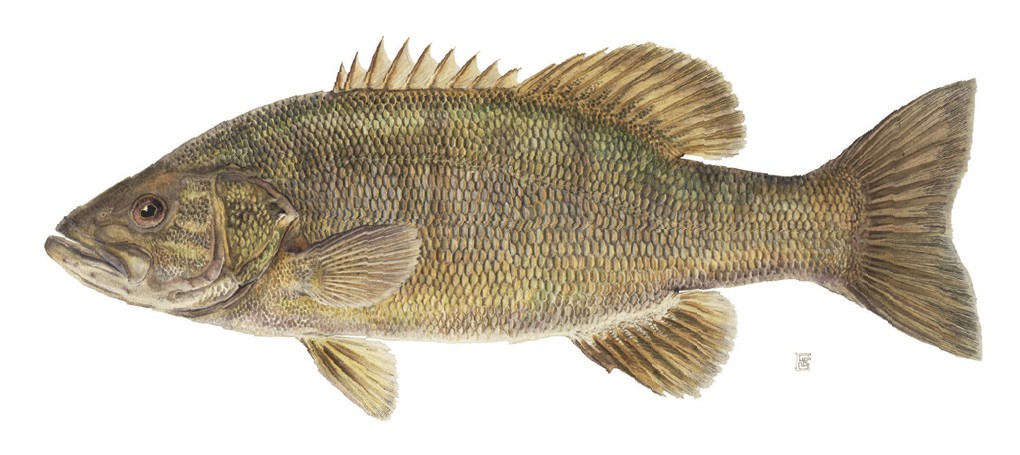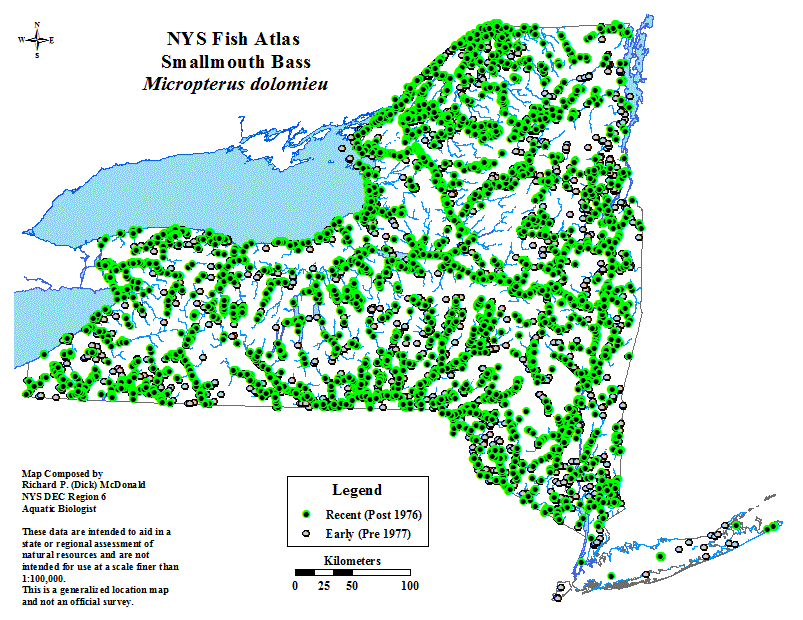
Smallmouth Bass (Micropterus dolomieui)
Smallmouth bass are now found in lakes and rivers throughout New York, but these fish were not originally widely distributed. During the mid-1800s, Dr. James Henshall, a Cincinatti physician with a passion for fishing, promoted smallmouth bass -- most commonly referred to at that time as "black bass" -- as a superior fish deserving broad distribution throughout the country. In 1881 Henshall published the Book of the Black Bass, in which he described black bass as follows:
"As a food fish, there are few, if any, more palatable freshwater fishes, its flesh being firm, white, and flaky, and when cooked, nutty, tender, and juicy; it has few bones and little offal, and as a pan fish is unexcelled. Its game qualities are second to none, and it will thrive and multiply in waters where the trouts can not exist."
Henshall relentlessly promoted smallmouth bass as worthy of residence in every suitable body of water in the United States, and relied upon patriotic arguments to make his case, as in this passage from his 1908 book, Favorite Fish and Fishing:
"The black bass is eminently an American fish, and has been said to be representative of his characteristics. He has the faculty of asserting himself and making himself completely at home wherever placed. He is plucky, game, brave and unyielding to the last when hooked. He has the arrowy rush and vigor of the trout, the untiring strength and bold leap of the salmon, while he has a system of fighting tactics peculiarly his own."
Smallmouth bass were not originally present in the Adirondacks, where their introduction into many lakes has had a strong negative impact on many native fishes, including native brook trout. Smallmouth bass's popularity as a sport fish and general habitat and temperature tolerances have led to the successful introduction of this species beyond its native range, including other continents (e.g. Europe, Guam, Hawaii, Hong Kong, Japan & Vietnam). Purposeful and unauthorized bass introductions have been particularly common in the northeastern U.S. and Canada, where the negative affects of these introductions on native fishes have begun to receive increasing attention. Recent studies have concluded that introduced smallmouth bass can reduce or eliminate native fishes by: 1) direct predation, or 2) indirectly modifying behaviors such that native fishes hide more and have less time to search for food. Bass can also out-compete native salmonids -- such as lake trout or brook trout -- for important prey fish, causing these predators to rely on less energetically attractive foods.
Young smallmouth bass feed upon aquatic insect larvae such as mayflies and dragonflies. As bass grow larger they begin to feed increasingly upon other fishes and crayfish. Smallmouth bass are uniquely suited for feeding upon crayfish, which provide an energy source not generally available to other fish predators. Smallmouth bass are usually found along lake shorelines, even during summer when they can tolerate warm nearshore water temperatures that cause trout predators to seek deepwater refuges. Larger smallmouth bass are generally found in association with underwater "structure", which is a general term describing large boulders, submerged trees or underwater vegetation. These habitats provide smallmouth bass with a place from which they can ambush prey, as well as a place to hide from avian (e.g. kingfishers, loons) or terrestrial predators (e.g. mink) looking for large fish to eat. In river and stream systems, smallmouth bass are usually found in warmer and wider reaches downstream from coldwater stretches more favorable for trout. Smallmouth bass are also very abundant along the rocky shoreline of large lakes, such as Lake Ontario and the Finger Lakes.
Distribution of smallmouth bass in NY state.
An image of smallmouth bass is also available for download.
